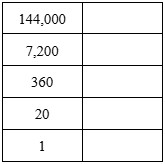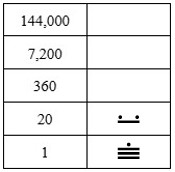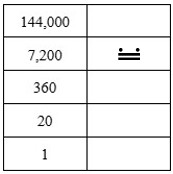14 Module 2.2 Numeration Systems
At this point, you may be thinking, "Why do I have to learn about all these other ways of writing numerals? I won't be teaching my students Egyptian hieroglyphics in math class." The short answer is that you are too comfortable and have too much experience with the Hindu-Arabic system. You do not have to think about the fact that 1,009 and 109 are two very different numbers. You just know it. This makes teaching it more difficult. As we look at two new systems in this section, keep track of where you get confused and what questions you have. These are likely similar issues your future students will have with the Hindu-Arabic system. As you work through your own questions, you are becoming better prepared to answer their questions!
Chinese Numerals
Chinese numerals are still used today. Symbols for some Chinese numerals are shown below.
| Number | Representation in Chinese |
|---|---|
| One | |
| Two | |
| Three | |
| Four | |
| Five | |
| Six | |
| Seven | |
| Eight | |
| Nine | |
| Ten | |
| [latex]\;\;\;\;\;\;\vdots[/latex] | [latex]\;\;\;\vdots[/latex] |
| Hundred | |
| [latex]\;\;\;\;\;\;\vdots[/latex] | [latex]\;\;\;\vdots[/latex] |
| Thousand |
Chinese numerals are formed by writing the symbols vertically and using the multiplicative principle, which simplifies the recording of numerals by eliminating the repetition of symbols. For instance, the Chinese write the numeral for 3,058 by thinking [latex]3 \times 1000 + 5 \times 10 + 8[/latex] and write down the symbols 3, 1000, 5, 10 and 8 in that order to represent that number. Even though you can think of the 8 as [latex]8 \times 1[/latex], the 1 is not written down. This Chinese numeral (3,058) is shown below on the left. The Chinese numeral for 872 is shown below on the right.
Representation of 3,058 |
Representation of 872 |
Below are some more Chinese numerals. Make sure you understand how to read all of them before trying the exercises.
6,400 |
87 |
9,531 |
2,605 |
4,011 |
7,000 |
Exercise 1
Write each Hindu-Arabic numeral as a Chinese numeral.
a. [latex]5093[/latex]
Solution
![]()
![]()
![]()
![]()
![]()
b. [latex]610[/latex]
Solution
![]()
![]()
![]()
![]()
c. [latex]427[/latex]
Solution
![]()
![]()
![]()
![]()
![]()
d. [latex]8008[/latex]
Solution
![]()
![]()
![]()
Exercise 2
Rewrite each Chinese numeral in Hindu-Arabic numerals.
a.
![]()
![]()
![]()
b.
![]()
![]()
![]()
![]()
![]()
c.
![]()
![]()
d.
![]()
![]()
![]()
![]()
![]()
![]()
![]()
e.
![]()
![]()
![]()
![]()
Notice in the Chinese system that numbers over nine have symbols written in pairs. To write 800, you must write the symbol for 8 above the symbol for 100. IMPORTANT NOTE: This is true even if there is only a "1" in the place value, see 2d above. You MUST remember to write the symbol for "one" above the symbol for "ten." Although the multiplicative principle allows you to write down fewer symbols than a simple additive system (for most numerals, at least), a further simplification would allow us to skip writing the second numeral of each pair. We could only do this if we used the position of the symbol to indicate the size of that group (10, 100, 1000, etc.) This type of system is called a positional numeration system. The Hindu-Arabic system is one example of a positional numeration system. In order to keep track of a position where no digit is used, a symbol for zero is necessary.
Fun Historical Fact: Since the Chinese system is not positional, it does not require a symbol for zero when writing out numerals. But, it is necessary in mathematics to have a zero when working with equations like [latex]3+0=3[/latex] and [latex](x-1)(x+2)=0[/latex]. The history of zero is widely contested, but it is generally believed that the Chinese developed the concept of zero before Western civilization. However, they did not designate a symbol for zero until much later.
Mayan Numerals
The final system we'll learn about in this section is similar to the Chinese system in that the symbols for the numerals are written from top to bottom, but it uses a positional system. Mayan Numerals were developed by the Mayan priests of southern Mexico and Central America around 300B.C. It is believed to be the earliest positional numeration system incorporating a zero and using it for a placeholder.
| Number | Representation in Mayan | Number | Representation in Mayan |
|---|---|---|---|
| Zero | Ten | ||
| One | Eleven | ||
| Two | Twelve | ||
| Three | Thirteen | ||
| Four | Fourteen | ||
| Five | Fifteen | ||
| Six | Sixteen | ||
| Seven | Seventeen | ||
| Eight | Eighteen | ||
| Nine | Nineteen |
Exercise 3
Consider the pattern of the Mayan numerals.
a. What value do you think a horizontal bar represents in each symbol?
Solution
It represents five.
b. What value do you think a dot represents in each symbol?
Solution
It represents one.
c. Describe how the system works for the numerals one to nineteen.
Solution
It's like the tally system, where you first list out groups of five then list singles, except you use a single bar to represent five and a dot to represent one.
From what you have seen of this system so far, it might look like a simple additive system. One might guess that the numeral for 20 would be four line segments and that the numeral for 103 would be twenty line segments and three dots. At first glance, it is very similar to the tally system. However, the Mayans used a vertical positional system.
- The bottom level represented how many units (1).
- The second level up represented how many 20's (20[latex]\times[/latex]1).
- The third level up represented how many 360's (18[latex]\times[/latex]20[latex]\times[/latex]1)
- The fourth level up represented how many 7,200's (20[latex]\times[/latex]18[latex]\times[/latex]20[latex]\times[/latex]1)
- The fifth level up represented how many 144,000's (20[latex]\times[/latex]20[latex]\times[/latex]18[latex]\times[/latex]20[latex]\times[/latex]1)
- Etc.

Except when moving from the second to the third level, each place value increased by a multiple of 20. It is almost a Base Twenty system except for that strange third level. Why the third level is 18 times the second level has to do with the Mayan calendar having 360 days; we will explore this later. Looking at the chart to the left, which shows the first five place values, may help you understand the system.
To try and make sense of all of this, we will look at some Mayan numerals that have more than one position now. The numerals from one to nineteen only utilize the bottom level, so it isn't apparent that the Mayan system is positional until you count past nineteen.
Mayan Example 1
State the Hindu-Arabic equivalent of the Mayan numeral shown below.
![]()
![]()
Solution:
This is a two-level Mayan numeral, so the bottom level has a place-value of one and the top level has a place-value of 20.

There is a 16 in the bottom level, representing 16 ones, or [latex]16 \times 1[/latex], plus there is a 7 in the second level up, representing 7 groups of twenty, or [latex]7 \times 20[/latex]. We add the values of each level, 16 + 140, so the numeral represents 156.
We have yet to see a numeral system that incorporated a symbol for zero. As previously mentioned, there needs to be a symbol for zero to incorporate the use of place value. As seen in the table above, the Mayans used a shell to represent zero.
Mayan Example 2
State the Hindu-Arabic equivalent of the Mayan numeral shown below.
![]()
![]()
Solution:
This is a two-level Mayan numeral with a zero in the bottom level, so again we have place-values of one and twenty.

The bottom row represents zero ones, or 0. There is a 13 in the second level up representing 13 groups of twenty, or 260 ([latex]13 \times 20[/latex]). So after adding the values together (0 + 260), the numeral you see represents the number 260.
Exercise 4

Exercise 5






How did you do? Make sure that if you still have any trouble understanding any of these that you go back and work through them again.
Now let's reverse the process. Given a Hindu-Arabic numeral we want to translate it into Mayan. The key is to think of our Mayan place-values as groupings.
Mayan Example 3
Write the Mayan numeral equivalents for each of the following numbers.
a. [latex]90008[/latex]
Solution:
We will again need our chart.

First we start by looking at the place-value closest to 90,008 that is smaller than 90,008. That means we are looking at 7,200. How many 7,200's are there in 90,008? Using a calculator, [latex]90008\div 7200=12.5011[/latex], so there are twelve 7,200's in 90,008. Thus we put the symbol for twelve in the 7,200 place.

Now we have used [latex]12\times 7200=86400[/latex] of our 90,008. This means we have [latex]90008-86400=3608[/latex] still to convert to Mayan. The next place-value down in our chart is 360. How many 360's are there in 3608? There are ten because [latex]360\times 10=3600[/latex]. Thus, we put the symbol for ten in the 360 place.

We now have [latex]3608-3600=8[/latex] remaining. We can not fit any 20's into 8, so that place-value needs a zero. This leaves 8 units, so we put the symbol for eight into the ones place.

Thus the final answer is:

Finally, check your answer by converting back to Hindu-Arabic:
[latex](12\times 7200)+(10\times 360)+(0\times 20)+(8\times 1)=90008[/latex]
b. [latex]720[/latex]
Solution:
The place-value closest to 720 without going over 720 is 360. How many 360's are there in 720? There are two of them. In fact, [latex]2\times 360=720[/latex], so our two 360's use ALL of 720. We have nothing left! So the rest of our place values are zero. Thus our answer is:

Checking our answer gives:
[latex](2\times 360)+(0\times 20)+(0\times 1)=720[/latex]
To convert a number to a Mayan numeral, the first thing you'll have to determine is how many levels the numeral will have. Remember the levels: 1, 20, 360, 7200, 144000, 2880000, etc. So any numeral less than 20 has one level, a numeral between 20 and 359 has two levels, a numeral between 360 and 7199 has three levels, a numeral between 7200 and 143999 has four levels, and so on.
When converting to Mayan numerals, it might help if you set up a table with the correct number of levels before you start. Be sure to include a space to fill in what symbol you'll be using at each level.
Exercise 6
Solution

Solution

Solution

Solution
Solution

Concept Check: Why is the following not a correct Mayan numeral? Hint: Think about the value in the 20's place.
![]()
Solution
You cannot have nineteen in the 20's place because [latex]19\times 20=380[/latex] which is larger than 360. As soon as there are 18 things in the 20's place they need to be traded to get one more in the 360's place. This means you cannot have more than a 17 in the 20's place. (Every other place-value can go up to 19.) The proper way to write the number is

You may be wondering why the Mayans chose 360 for the third level up instead of 400, which seems more natural. Their counting system was based on their calendar, which consisted of 18 months of 20 days each, hence 360. The extra five days were considered "useless" and they didn't worry about them. Their system made it easy to count time. They didn't count the "useless days." For instance, consider the following:
| Days in 1 year | Days in 2 years | Days in 3 years | Days in 5 months, 9 days | Days in 8 years, 11 months |
Exercise 7
Write the Mayan numeral for the number of (non-useless) days in
a. 7 months, 15 days
Solution

b. 13 Mayan years
Solution
![]()
c. 20 Mayan years
Solution

To properly teach the Hindu-Arabic system to your future students, it is important to understand the differences between it and other numeration systems. The final exercises of this section will be to compare the Hindu-Arabic, Chinese, and Mayan numerals.
Exercise 8
State how many different symbols a person has to memorize to understand each system.
a. Hindu-Arabic
Solution
Ten symbols: 0, 1, 2, 3, 4, 5, 6, 7, 8, and 9
b. Chinese
Solution
At least 12, but that only gets you into the thousands place and doesn't include zero.
c. Mayan
Solution
Three basic ones: zero, dot, and line. Though technically, you need to understand 19 different combinations of dot and line.
Exercise 9
Write each number as a numeral in Chinese and Mayan. Note how many symbols it takes to write the given number in Hindu-Arabic, Chinese, and Mayan.
a. [latex]15[/latex]
Solution
Chinese
![]()
![]()
![]()
Mayan
![]()
Number of symbols: Hindu-Arabic - 2, Chinese - 3, Mayan - 1
b. [latex]100[/latex]
Solution
Chinese
![]()
![]()
Mayan
Number of symbols: Hindu-Arabic - 3, Chinese - 2, Mayan - 2
c. [latex]1000[/latex]
Solution
Chinese
![]()
![]()
Mayan
![]()
![]()
![]()
Number of symbols: Hindu-Arabic - 4, Chinese - 2, Mayan - 3
d. [latex]9999[/latex]
Solution
Chinese
![]()
![]()
![]()
![]()
![]()
![]()
![]()
Mayan
![]()
![]()
![]()
![]()
Number of symbols: Hindu-Arabic - 4, Chinese - 7, Mayan - 4
